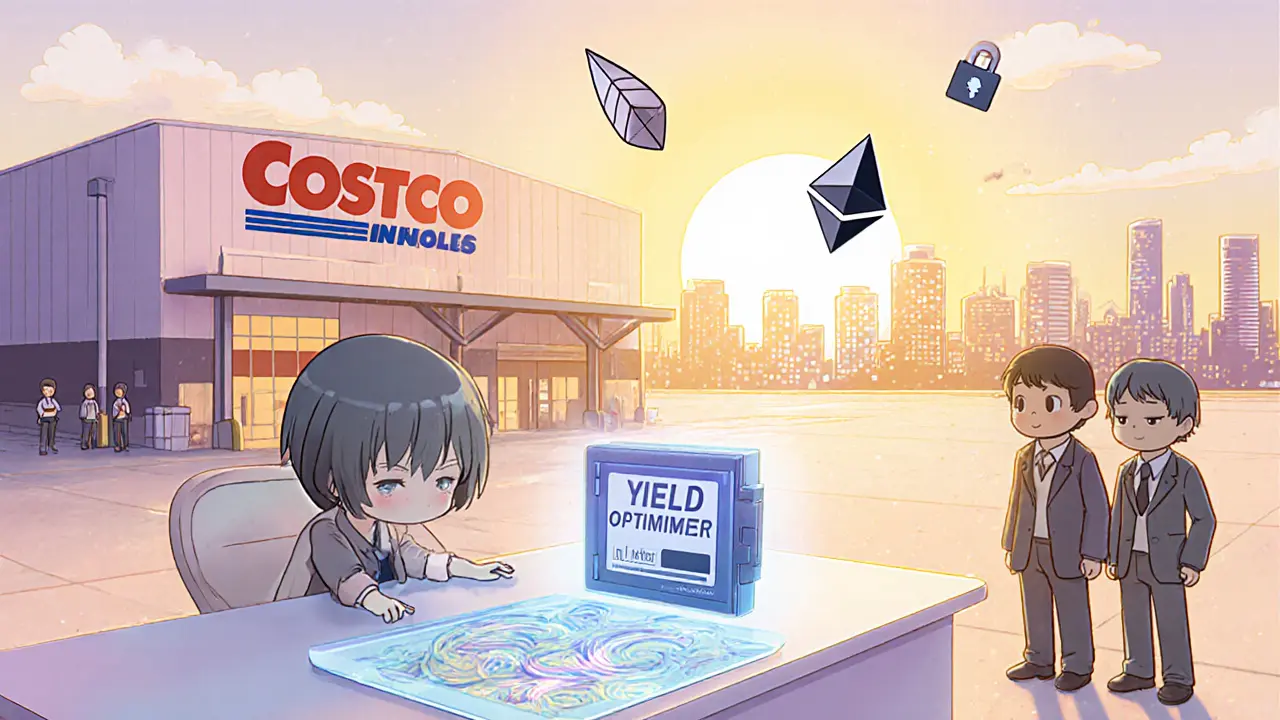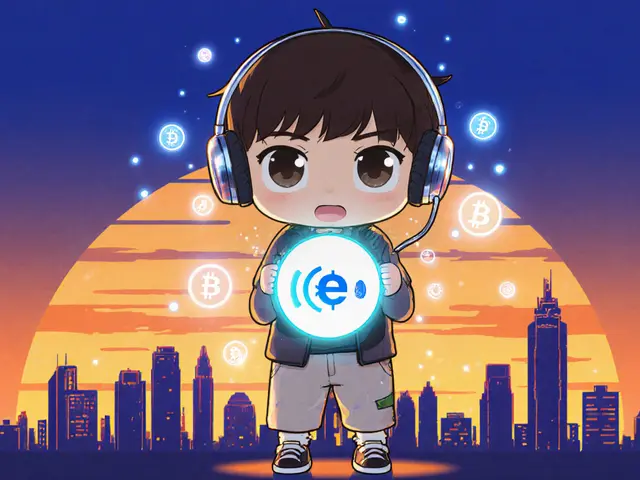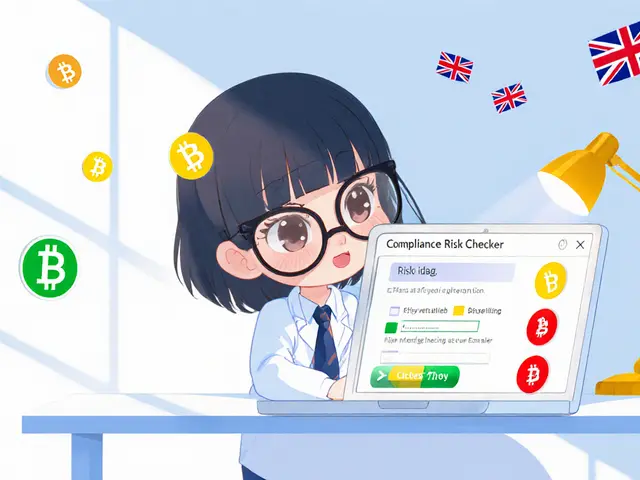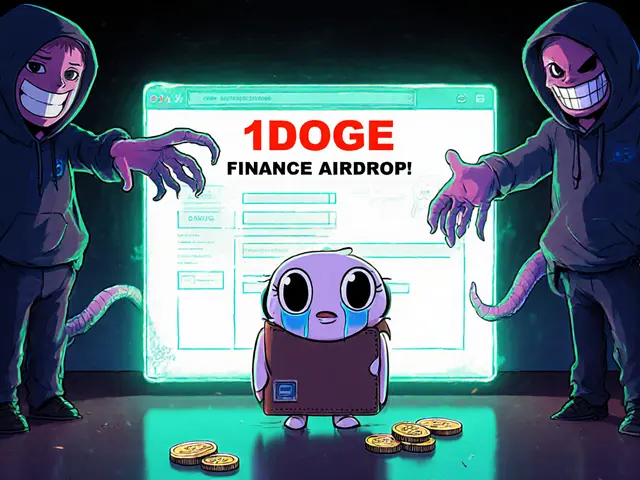Costco Tokenized Stock (COSTon) Calculator
Investment Value Calculator
Estimate the value of your COSTon holdings based on current market conditions.
Investment Summary
Total Value:
Risk Level:
Market Cap:
24h Volume:
Risk Assessment
Evaluate key risk factors associated with investing in COSTon.
Risk Analysis
Ever wondered how you could own a slice of Costco without opening a brokerage account? Costco tokenized stock makes that possible by turning the giant retailer’s shares into a crypto‑friendly ERC‑20 token. In this guide we’ll break down what COSTon actually is, how it lives on Ethereum, why it matters for DeFi fans, and what pitfalls you should watch out for before you dive in.
- Costco tokenized stock (COSTon) is an ERC‑20 token that mirrors Costco’s share price and auto‑reinvests dividends.
- It runs on the Ethereum blockchain via a contract created by Ondo Finance.
- Key benefits: 24/7 trading, fractional ownership, and DeFi composability.
- Major risks: low liquidity, price discrepancies across exchanges, and regulatory uncertainty.
- Getting started requires an Ethereum‑compatible wallet, KYC on the Ondo platform, and access to a supported exchange.
What Is COSTon?
COSTon is a blockchain‑based token that represents a single share of Costco Wholesale Corporation. The token was minted by Ondo Finance, a fintech firm that specializes in bringing real‑world assets onto Ethereum. Each COSTon token follows the ERC‑20 standard, meaning it can be stored in any wallet that supports Ethereum and traded on platforms that list ERC‑20 assets.
The token’s ticker is COSTon, and its contract address is 0x0c8276e4fec072cf7854be69c70f7773d1610857. Because the token is pegged to Costco’s actual stock, its market price should theoretically move in lockstep with the underlying equity, adjusted for any fees or dividend reinvestment mechanisms built into the smart contract.
How Does the Token Work on Ethereum?
When you buy COSTon, you’re not purchasing a traditional share through a broker. Instead, you’re acquiring an ERC‑20 token that holds a claim on the underlying Costco shares held in a custodial pool managed by Ondo Finance. The pool receives the real shares, collects dividend payouts, and then automatically reinvests those dividends back into the pool, increasing the net asset value (NAV) of each token.
Because the token lives on Ethereum, it inherits all of Ethereum’s properties: decentralised ledger, atomic settlement, and compatibility with DeFi protocols. For example, you can lock COSTon in a yield‑optimising vault, collateralise it for a stablecoin loan, or swap it on a decentralized exchange (DEX) without ever leaving the blockchain.
Benefits Compared to Direct Costco Share Ownership
From a traditional investor’s perspective, buying a Costco share means dealing with a brokerage, paying settlement fees, and being limited to market hours. COSTon flips that script:
- 24/7 Trading: The token can be bought or sold any time, regardless of NYSE hours.
- Fractional Ownership: You can own 0.001 of a share, which is useful when the stock price is high.
- DeFi Integration: Use the token as collateral, earn extra yield, or participate in liquidity pools.
- Automatic Dividend Re‑investment: Dividends are baked back into the token’s NAV, removing the need for manual reinvestment.
Risks and Drawbacks
While the upside looks shiny, the reality is messier. The token’s market data shows stark inconsistencies: one source reports a total supply of 0.5197COSTon, while another lists 1,170.61COSTon for the same date. Price feeds also diverge, with Crypto.com quoting $916.72 and Coinbase’s converter showing $971.58 per token. These gaps hint at low liquidity and fragmented pricing.
Other red flags include:
- Regulatory Ambiguity: Tokenized securities sit in a gray area between securities law and crypto regulation. A future SEC ruling could force the token off exchanges.
- Counterparty Risk: The underlying shares are held by Ondo Finance. If the custodian mismanages the pool, token holders could lose value.
- Limited Exchange Access: Currently only a handful of platforms list COSTon, narrowing the avenues for buying or selling.
- Price Discrepancies: Because the token trades on both centralized and decentralized venues, arbitrage opportunities exist but are hard to exploit for small investors.

Current Market Snapshot (September2025)
As of early September 2025, the token’s market cap hovered around $489, with a 24‑hour trading volume of roughly $4,400 on one listing and $21,500 on another. Only 28 wallets held the token, representing a modest 115% increase from the previous month but still an extremely thin user base. Monthly transfer volume sits at about $3,300, indicating that most holders are either long‑term investors or simply observing the market.
Regulatory Landscape
The token lives in the emerging “Real World Assets” (RWA) sector, where blockchain projects try to bring tangible assets onto chain. Regulators worldwide are still figuring out how to treat such tokens. In the United States, the SEC has signalled that any token granting ownership rights to a public company’s equity could be deemed a security, requiring registration or an exemption. Ondo Finance claims compliance, but the lack of clear guidance means the token could be pulled from exchanges if a regulator deems it non‑compliant.
How to Acquire and Store COSTon
Getting your hands on the token involves a few steps:
- Set up an Ethereum‑compatible wallet (MetaMask, Trust Wallet, etc.).
- Buy ETH to cover gas fees.
- Complete KYC on the Ondo platform (or a partnered exchange that lists COSTon).
- Transfer ETH to the exchange’s deposit address and place a market or limit order for COSTon.
- Withdraw the tokens to your personal wallet for full control, or keep them on the exchange if you prefer easy liquidity.
Remember that moving ERC‑20 tokens incurs gas costs, which can spike during network congestion. Always double‑check the contract address before sending any funds.
Comparison: COSTon vs Direct Costco Shares vs Other Tokenized Stocks
| Feature | COSTon (Ondo) | Costco Share (NYSE) | sCOST (Synthetix) |
|---|---|---|---|
| Underlying Asset | Custodied Costco shares + smart contract | Actual equity certificate | Synthetic representation (no real shares) |
| Trading Hours | 24/7 on Ethereum | NYSE hours (9:30am-4:00pm ET) | 24/7 on Layer‑2 |
| Fractional Ownership | Yes, down to 0.0001 token | Typically whole shares (broker may allow fractions) | Yes, any amount |
| Dividend Handling | Auto‑reinvested into NAV | Paid quarterly to shareholders | No real dividends (synthetic reward token) |
| Liquidity | Low (few exchanges, small volume) | High (large market cap, many venues) | Medium (DeFi pools, but dependent on token demand) |
| Regulatory Status | Unclear, potential security | Fully regulated equity | Generally considered a derivative, varies by jurisdiction |
Future Outlook
The token’s fate hinges on three forces: regulatory clarity, liquidity upgrades, and platform development. If the SEC issues a clear exemption or guideline, projects like COSTon could see a surge of institutional interest, bringing deeper order books and tighter spreads. On the technical side, integration with Layer‑2 solutions (e.g., Optimism) could shave gas fees, making everyday trading more appealing. Finally, Ondo’s roadmap promises broader RWA offerings, which could attract investors looking for diversified exposure beyond single‑stock tokens.
Until those pieces fall into place, treat COSTon as a speculative, experimental asset-interesting for DeFi enthusiasts who want exposure to a blue‑chip retailer, but risky for traditional investors seeking stability.

Frequently Asked Questions
Is COSTon a real security?
COSTon claims to be a tokenized representation of Costco shares, but regulators have not formally classified it. In the United States it could be treated as a security, meaning it may be subject to SEC oversight.
How are dividends handled?
Dividends collected from the custodial pool are automatically reinvested, increasing each token’s net asset value. Holders do not receive cash payouts directly.
Where can I trade COSTon?
COSTon is listed on a few centralized exchanges such as Crypto.com and appears on some decentralized exchanges via the Ondo Global Markets portal. Availability varies by region.
Do I need a special wallet?
Any wallet that supports ERC‑20 tokens works-MetaMask, Trust Wallet, Ledger, etc. Just make sure you keep the contract address handy.
Is the token price always equal to Costco’s stock price?
In theory the token should track the share price plus dividend NAV. In practice price gaps appear due to low liquidity and differing exchange feeds.
What are the tax implications?
Tax treatment varies by jurisdiction. In many countries, crypto‑type assets are taxed on capital gains, while dividends (re‑invested) may have separate tax rules. Consult a tax professional.
Ready to experiment? If you’re comfortable navigating DeFi and accepting the risk, COSTon offers a novel way to hold a retail titan on the blockchain. If you prefer the safety of a regulated brokerage, stick with traditional Costco shares and keep an eye on the tokenized‑stock space for future improvements.







Bobby Ferew
January 23, 2025 AT 02:56The tokenization narrative is drenched in buzz‑speak and regulatory opacity-while the promise of 24/7 fractional exposure sounds alluring, the underlying custodial mechanics raise liquidity shadows that could gnaw at any risk‑averse palate. Moreover, the ERC‑20 wrapper adds gas‑fee friction that many casual investors overlook. In short, hype often eclipses hard‑core fundamentals.
celester Johnson
January 25, 2025 AT 21:36When we speak of ownership in the digital age, we are really redefining the metaphysics of property; a token like COSTon attempts to map a physical equity onto an immutable ledger, echoing Plato’s allegory of the cave where shadows become reality. Yet the veil of decentralisation often masks the very custodial relationships it claims to dissolve. The experience feels like a paradox: freedom through code, dependence on a central entity. Such contradictions merit a deeper contemplation beyond surface‑level ROI calculations.
Prince Chaudhary
January 28, 2025 AT 16:16Venturing into tokenized assets can be an empowering step for DeFi newcomers, provided you respect the boundaries of due diligence. Verify the smart‑contract address, assess the custodial backing, and keep your exposure modest until the market matures. This measured enthusiasm helps you avoid unnecessary pitfalls while still learning the ropes of blockchain‑based equities.
John Kinh
January 31, 2025 AT 10:56Looks like a gimmick wrapped in hype.
Mark Camden
February 3, 2025 AT 05:36From a securities law perspective, any token that confers economic rights akin to a share is likely to be classified as a security under the Howey test, obligating the issuer to register with the SEC or qualify for an exemption. Ondo’s claim of compliance hinges on the custodial arrangement, yet the public disclosures remain ambiguous. Furthermore, the token’s limited secondary market depth raises concerns about market manipulation. Investors should demand transparent reporting and a clear regulatory roadmap before allocating capital.
Evie View
February 6, 2025 AT 00:16Stop buying this speculative junk; it’s a cash‑drain that will erode your portfolio faster than you can say “dividend‑reinvestment”.
Sidharth Praveen
February 8, 2025 AT 18:56If you want a taste of Costco’s steady cash flow without the broker, tokenized stock is a fun experiment-just keep an eye on gas fees and the thin order books that could bite on larger trades.
Sophie Sturdevant
February 11, 2025 AT 13:36Alright team, when you dip into COSTon, treat it like any other DeFi asset: verify the contract, lock in your exposure, and don’t let FOMO dictate position sizing. Remember, risk management is your best ally.
Nathan Blades
February 14, 2025 AT 08:16The concept of a tokenized Costco share is alluring on paper because it promises 24/7 liquidity for a traditionally illiquid equity.
In practice, the market depth is minuscule, meaning even modest orders can shift the price dramatically.
The auto‑reinvestment of dividends simplifies the total‑return calculation, but it also masks the cash flow that would otherwise be visible to shareholders.
Because the token lives on Ethereum, you inherit both the benefits of composability and the pain of volatile gas costs.
Layer‑2 solutions could alleviate the fee burden, yet most exchanges still route trades through the mainnet.
Regulatory ambiguity remains the biggest elephant in the room, as the SEC has hinted that such tokens may be securities.
Ondo’s custodial pool provides a veneer of compliance, but the lack of a public audit leaves investors guessing.
Liquidity providers on decentralized exchanges can earn fees, but the reward is often offset by impermanent loss in a low‑volume environment.
Centralized listings on platforms like Crypto.com offer tighter spreads, but they come with KYC requirements that some DeFi users find off‑putting.
The price discrepancies you notice across venues are a natural consequence of fragmented order flow.
Arbitrage opportunities exist, but they demand sophisticated bots and capital that most retail participants lack.
From a portfolio perspective, allocating a small percentage to COSTon can diversify exposure to a blue‑chip retailer without the broker’s custody risk.
However, the counter‑party risk inherent in the custodial arrangement cannot be ignored.
Investors should model both the on‑chain and off‑chain risk factors before committing capital.
In summary, the token is a fascinating experiment that sits at the intersection of traditional equity and decentralized finance.
Treat it as a speculative side‑project rather than a core holding, and you’ll likely avoid the worst of its volatility.
Somesh Nikam
February 17, 2025 AT 02:56The token’s auto‑reinvesting dividend mechanism simplifies total return calculations, yet you must still account for the underlying custodial risk in your portfolio models.
Jan B.
February 19, 2025 AT 21:36COSTon mirrors Costco shares but has low volume That means slippage can be high So trade small amounts
MARLIN RIVERA
February 22, 2025 AT 16:16This token is a textbook example of regulatory arbitrage masquerading as innovation, and anyone serious about capital preservation should steer clear.
Debby Haime
February 25, 2025 AT 10:56Grab the chance to learn how tokenized equities work-experience the future while staying grounded in solid research.
emmanuel omari
February 28, 2025 AT 05:36Our local investors deserve real assets, not foreign‑crafted crypto replicas that could be wiped out by external regulators.
Andy Cox
March 3, 2025 AT 00:16I see the tech behind COSTon and think it’s cool but the market is still tiny so patience is key.
Courtney Winq-Microblading
March 5, 2025 AT 18:56In the grand tapestry of value, a token is a whisper of the physical, a digital echo that begs us to ask what ownership truly feels like.
katie littlewood
March 8, 2025 AT 13:36Honestly, when we contemplate the elegance of turning a brick‑and‑mortar behemoth like Costco into a slice of code, we are witnessing a cultural shift that stretches beyond mere finance; it is an invitation to reimagine the very scaffolding of equity participation. The fact that a handful of wallets now hold the entirety of this token underscores both the exclusivity and the early‑stage volatility that characterize nascent markets. Yet, for those willing to navigate the choppy waters of regulatory gray zones and gas‑price spikes, the reward is not solely monetary-it is also the satisfaction of being part of an experimental frontier. Moreover, the auto‑reinvestment feature, while seemingly convenient, subtly alters the compounding dynamics that traditional shareholders enjoy, demanding a fresh analytical lens. Ultimately, whether you view COSTon as a daring venture or a speculative folly, the conversation it sparks about the democratization of assets is undeniably profound.
Jenae Lawler
March 11, 2025 AT 08:16While the broader consensus extols the virtues of tokenized equities, one must scrutinize the structural deficiencies inherent in their current market infrastructure, notably the paucity of robust liquidity providers and the opaque custodial arrangements that expose investors to undue counter‑party risk.
Chad Fraser
March 14, 2025 AT 02:56Hey folks, if you’re curious about diving in, start with a tiny amount, watch the spreads, and share what you learn with the community.
Jayne McCann
March 16, 2025 AT 21:36I don’t think it’s worth the hassle.
Richard Herman
March 19, 2025 AT 16:16Both the innovative potential and the regulatory gray area deserve equal attention when assessing COSTon.
Parker Dixon
March 22, 2025 AT 10:56🚀 Stay curious, keep your risk low, and enjoy the experiment! 🌟